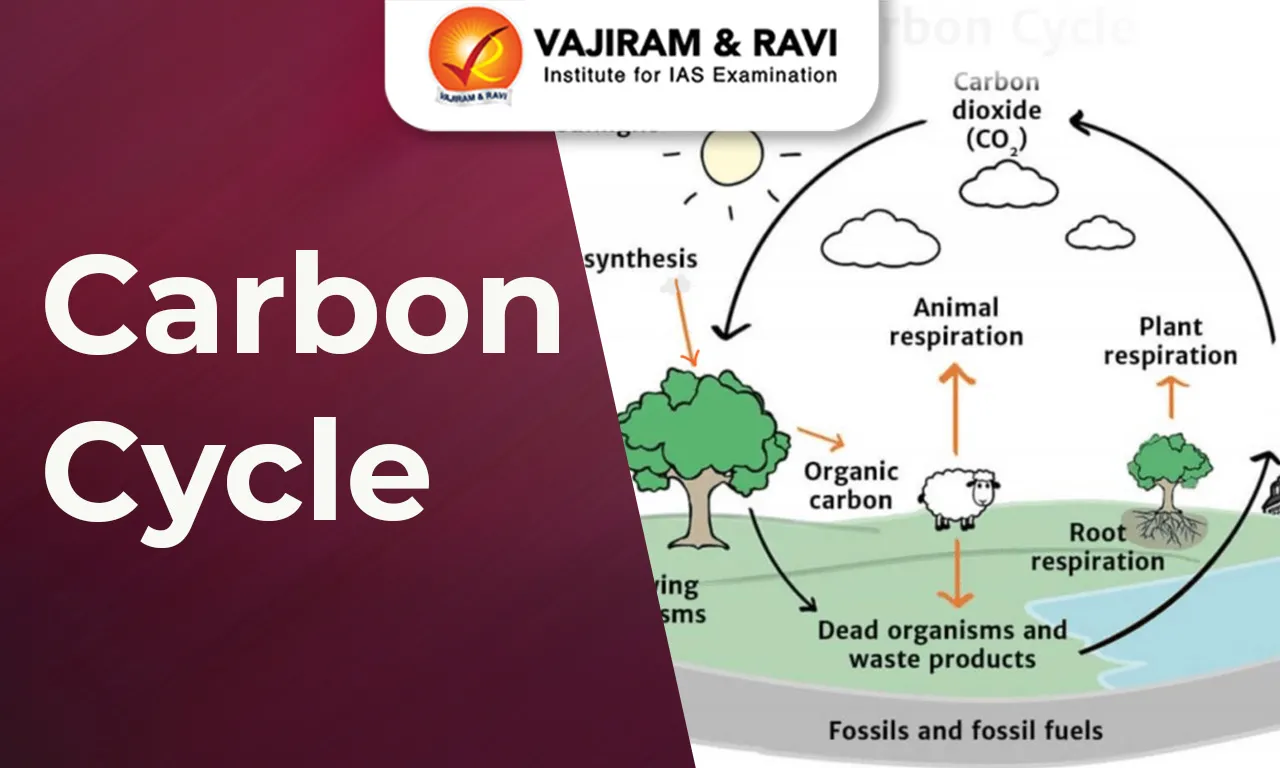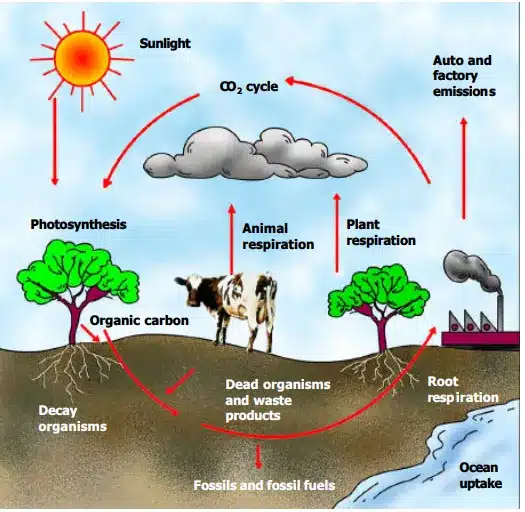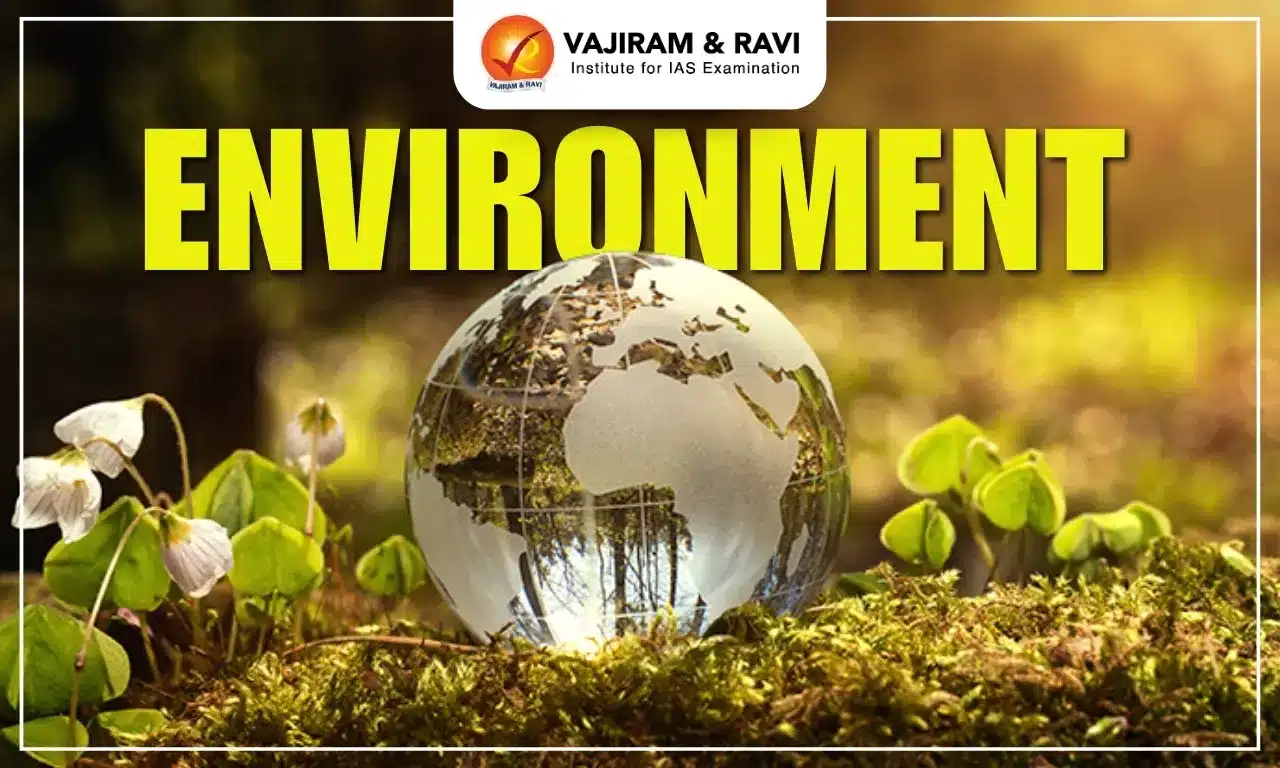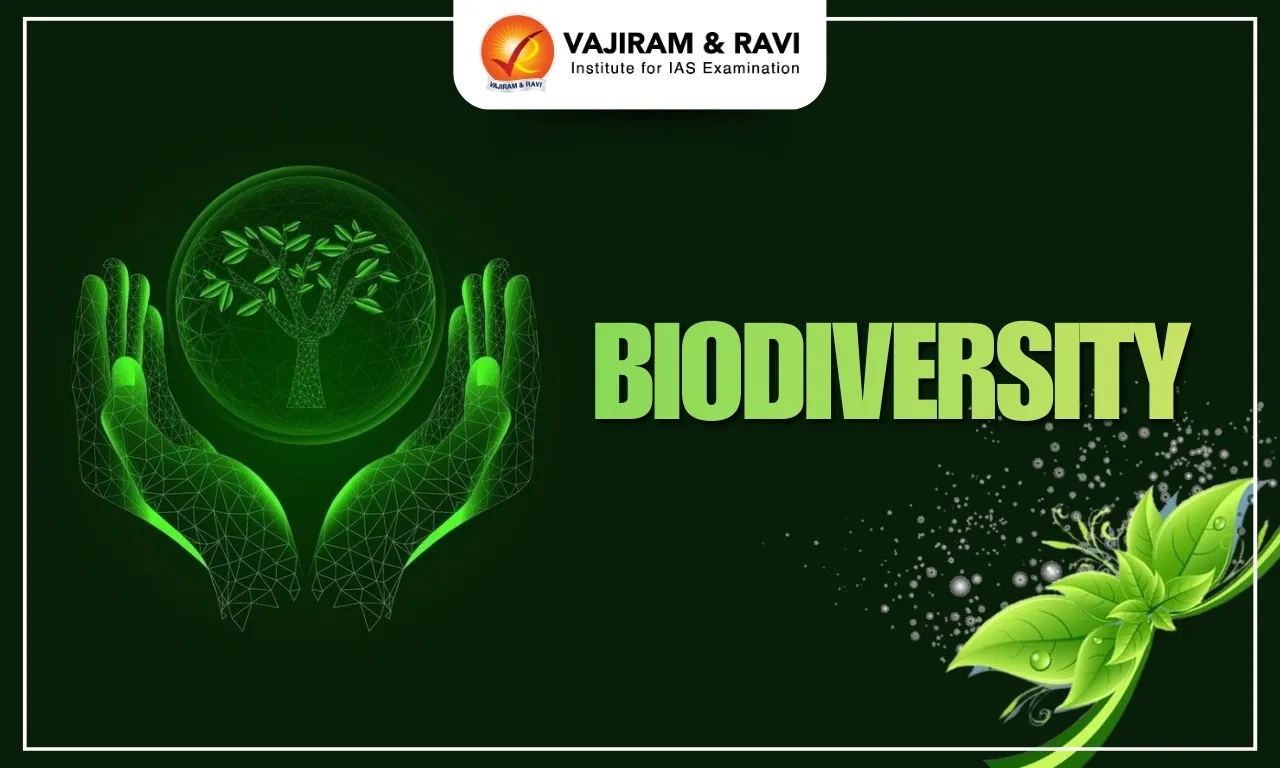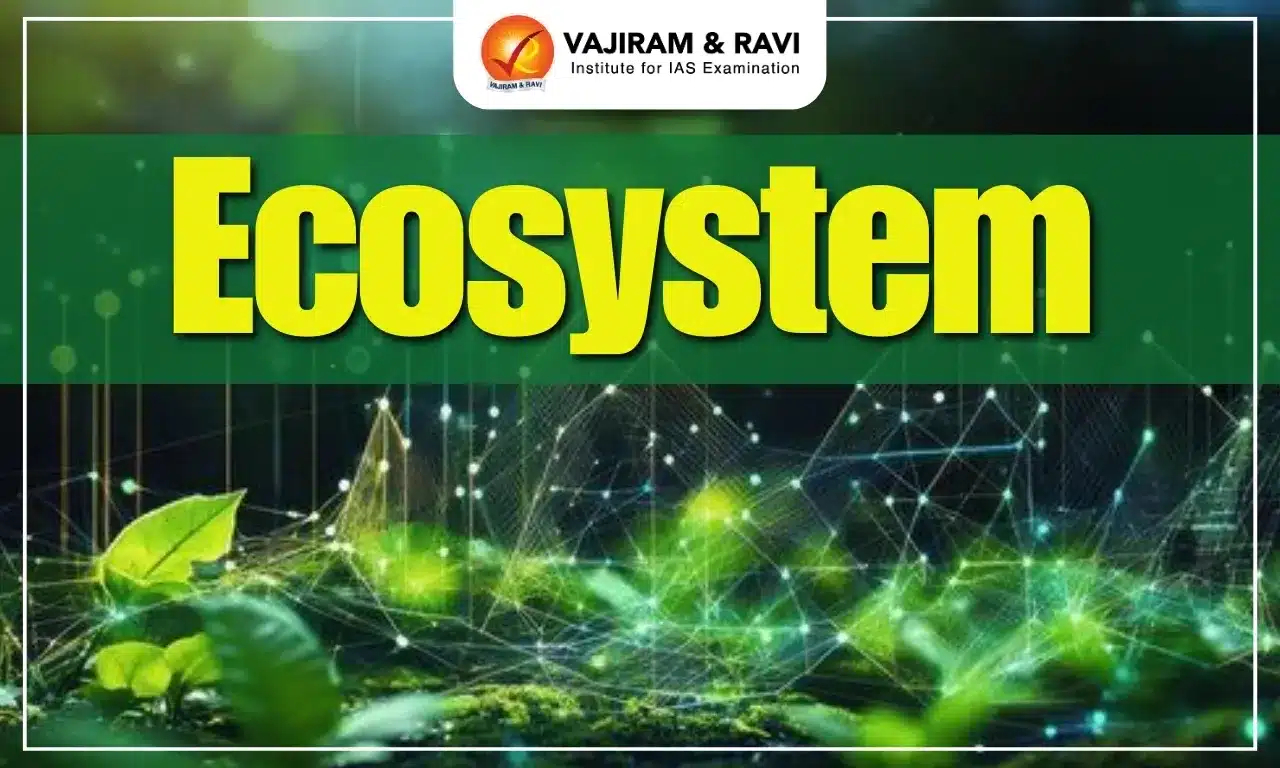Carbon cycle refers to the movement of carbon between living organisms like plants, animals, and microbes, as well as the earth's minerals and the atmosphere. It plays a critical role in life processes, regulating Earth's temperature and supporting ecosystems. Key processes include photosynthesis, respiration, consumption, and decomposition, which help cycle carbon through various forms like CO2 and organic matter.
The cycle involves different forms of carbon, such as blue, green, brown, and black carbon. These types are stored in ecosystems like oceans and forests and impact climate regulation. Disruptions in the carbon cycle, like increased CO2 levels, can cause global warming, sea-level rise, and ecosystem damage.
Carbon Cycle Definition
The carbon cycle refers to the movement of carbon between living organisms like plants, animals, and microbes, as well as the earth's minerals and the atmosphere. As the fourth most abundant element in the universe, carbon plays a critical role in forming complex molecules like DNA and proteins, making life on Earth possible.
- In the atmosphere, carbon exists as carbon dioxide (CO2), crucial in regulating Earth's temperature.
Carbon Cycle Process
The carbon cycle regulates the movement of carbon between organisms, the earth, and the atmosphere through processes like assimilation, consumption, and respiration. These are explained below in detail:
- Assimilation of Carbon: CO2 enters plants through stomata and is converted into sugars via photosynthesis, called carbon assimilation or fixation.
- Consumption of Fixed Carbon: Fixed carbon moves through food chains, as herbivores eat plants and carnivores consume herbivores. It eventually returns to the atmosphere through respiration and decomposers.
- Aerobic Respiration and CO2 Release: Organisms release CO2 and energy through aerobic respiration. Decomposers break down organic matter, releasing carbon during mineralization.
- Temporary Carbon Storage: In swamps and marshes, incomplete decomposition forms peat or coal. In oceans, carbon is stored in calcium carbonate, forming shells and limestone sediments.
- Rising CO2 Levels and Global Warming: Increased atmospheric CO2 from fossil fuel burning and deforestation enhances the greenhouse effect, causing global warming, sea-level rise, and climate change.
Carbon Cycle Diagram
The carbon cycle diagram illustrates the movement of carbon through various Earth systems, including the atmosphere, oceans, and land ecosystems. It highlights the processes of carbon storage, absorption, and release, essential for maintaining a balanced climate.
Carbon Cycle on Land
The carbon cycle on land involves processes such as photosynthesis, respiration, consumption, decomposition, and biomass combustion, through which carbon moves between the atmosphere, plants, animals, and soil. These are explained below in detail:
- Photosynthesis: Plants take carbon dioxide (CO2) directly from the atmosphere and convert it into biomass, such as leaves and stems.
- Respiration: Plants, animals, and microbes return carbon to the atmosphere as carbon dioxide (CO2) through respiration.
- Consumption: As herbivores consume plants and carnivores consume herbivores, carbon moves up the food web.
- Decomposition: When organisms die and decay, carbon returns to the atmosphere or integrates into the soil.
- Biomass combustion: Wildfires release significant amounts of carbon stored in plants back into the atmosphere.
Oceanic Carbon Cycle
The oceanic carbon cycle involves the exchange of carbon between the ocean, atmosphere, Earth's interior, and seafloor. It is a crucial part of the global carbon cycle. These are explained below in detail:
- Carbon Reservoirs: The ocean stores roughly 38,000 gigatons of carbon (Gt/C), mainly as dissolved inorganic carbon, which accounts for about 95% of the total active carbon pool on Earth's surface.
- Air-Sea Exchange: The ocean absorbs and releases carbon dioxide (CO2) through gas exchange with the atmosphere.
- Biological Pump: Phytoplankton in the surface ocean absorb CO2 through photosynthesis and convert it into organic carbon. When these organisms die, some carbon sinks into the deep ocean, where it can be stored for long periods.
- Temperature Influence: Cold water absorbs more CO2 than warm water, leading to higher absorption rates in polar regions. This cold water eventually sinks and flows through deep ocean currents.
- Sinking Shells: Shell-building organisms transport carbon to the deep ocean when they die. Undissolved shells form calcium carbonate sediments, which tectonic processes transform into limestone over millions of years, locking away massive amounts of carbon.
- Long-Term Carbon Storage: Carbon that sinks into the deep ocean can be locked away for millennia, playing a crucial role in mitigating climate change.
Carbon Cycle Importance
The carbon cycle regulates Earth's temperature, supports life, and maintains ecosystems, ensuring climate stability and preserving biodiversity. These are explained below in detail:
- Regulates Earth's Temperature: The carbon cycle helps maintain a stable climate by controlling the amount of carbon dioxide (CO2) in the atmosphere, which regulates Earth's temperature.
- Ecosystem Functionality: The carbon cycle allows ecosystems to function properly by cycling carbon through the atmosphere, oceans, plants, animals, and fossil fuels.
- Energy Source: Carbon is a critical component of fossil fuels, which are used for energy production. The cycle ensures that carbon moves between natural sources and sinks.
- Maintains Carbon Balance: The carbon cycle ensures a balance between carbon reservoirs (such as oceans, plants, and the atmosphere), allowing life to thrive and preventing dangerous carbon buildup.
- Prevents Climate Disruptions: A stable carbon cycle prevents excessive CO2 from accumulating in the atmosphere, thus avoiding the trapping of heat, which leads to global warming.
- Sustains the Global Food Chain: Plants use carbon dioxide in photosynthesis to produce food, which is then consumed by animals and humans, supporting the entire global food chain.
Carbon Cycle Disruption Consequences
The disruption of the carbon cycle intensifies global warming, leading to severe consequences for the environment. These include extreme weather events, rising sea levels, and ecosystem destruction. These are explained below in detail:
- Ocean Acidification: Excess carbon dioxide dissolves in seawater, forming carbonic acid, which lowers ocean pH. This process harms marine life, including corals and shellfish, threatening marine ecosystems and food sources.
- Melting Ice Caps and Glaciers: Rising temperatures cause polar ice caps and glaciers to melt, reducing the Earth's ability to reflect sunlight, which accelerates global warming, and creates a dangerous feedback loop.
- Loss of Biodiversity: As habitats are destroyed or altered too quickly due to climate change, species face extinction risks. Coral reefs bleach, forests decline, and ecosystems fragment, threatening biodiversity.
- Rising Sea Levels: Melting ice caps and glaciers contribute to rising sea levels, which increase coastal flooding, storm surges, and saltwater intrusion, displacing populations and disrupting economies.
- Permafrost Thawing and Methane Release: As Arctic permafrost thaws, it releases large amounts of methane—a potent greenhouse gas—accelerating global warming and further destabilizing the carbon cycle.
Carbon Cycle UPSC PYQ
Q1. Which of the following adds/adds carbon dioxide to the carbon cycle on the planet Earth? (UPSC Prelims 2014)
- Volcanic action
- Respiration
- Photosynthesis
- Decay of organic matter
Select the correct answer using the code given below.
(a) 1 and 3 only
(b) 2 only
(c) 1, 2, and 4 only
(d) 1, 2, 3 and 4
Ans. (c)
Q2. What is blue carbon? (UPSC Prelims 2021)
(a)Carbon captured by oceans and coastal ecosystems
(b) Carbon sequestered in forest biomass and agricultural soils
(c) Carbon contained in petroleum and natural gas
(d) Carbon present in the atmosphere
Ans: (a)
Q3. Biological Oxygen Demand (BOD) is a standard criteria for (UPSC Prelims 2017)
(a) Measuring oxygen level in blood
(b) Computing oxygen levels in forest ecosystems
(c) Pollution assay in aquatic ecosystem
(d) Assessing oxygen levels in high-altitude regions
Ans: (c)
Last updated on November, 2025
→ Check out the latest UPSC Syllabus 2026 here.
→ Join Vajiram & Ravi’s Interview Guidance Programme for expert help to crack your final UPSC stage.
→ UPSC Mains Result 2025 is now out.
→ UPSC Notification 2026 is scheduled to be released on January 14, 2026.
→ UPSC Calendar 2026 is released on 15th May, 2025.
→ The UPSC Vacancy 2025 were released 1129, out of which 979 were for UPSC CSE and remaining 150 are for UPSC IFoS.
→ UPSC Prelims 2026 will be conducted on 24th May, 2026 & UPSC Mains 2026 will be conducted on 21st August 2026.
→ The UPSC Selection Process is of 3 stages-Prelims, Mains and Interview.
→ UPSC Result 2024 is released with latest UPSC Marksheet 2024. Check Now!
→ UPSC Prelims Result 2025 is out now for the CSE held on 25 May 2025.
→ UPSC Toppers List 2024 is released now. Shakti Dubey is UPSC AIR 1 2024 Topper.
→ UPSC Prelims Question Paper 2025 and Unofficial Prelims Answer Key 2025 are available now.
→ UPSC Mains Question Paper 2025 is out for Essay, GS 1, 2, 3 & GS 4.
→ UPSC Mains Indian Language Question Paper 2025 is now out.
→ UPSC Mains Optional Question Paper 2025 is now out.
→ Also check Best IAS Coaching in Delhi
Carbon Cycle FAQs
Q1. What are the 4 steps of the carbon cycle?+
Q2. What are the 7 parts of the carbon cycle?+
Q3. What is the Carbon Cycle & Why is it So Important?+
Q4. What are the 2 types of carbon cycles?+
Q5. What is the carbon cycle full?+



